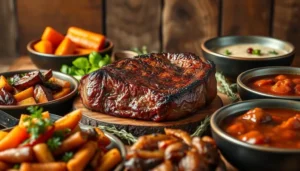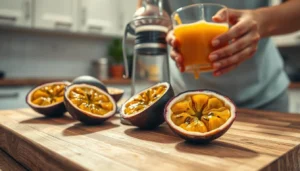Imagine coming home to a cozy kitchen full of comforting aromas from salmon stew simmering away on the stove, ready to turn into dinner plans for tonight. This simple recipe offers quick yet flavorful meals in no time at all!
Preparing this salmon stew is extremely straightforward. Packed full of essential vitamins and nutrients, its flavour makes this an ideal way to enjoy delicious food without spending hours cooking it yourself. Perfect for anyone seeking delicious meals without too much hassle from cooking!
With just a few ingredients and 20-30 minutes of preparation time, you’ll have an amazing meal to look forward to. Our recipe allows for customization while remaining straightforward and straightforward.
Understanding the Rich Heritage of Salmon Stew recipe
Salmon stew is an unforgettable culinary journey, stretching across continents and cultures alike. What may have started out as a simple seafood dish has now become an cherished tradition – discover its history!

Salmon chowder’s history can be found in coastal communities where seafood was more than food; it was part of their way of life and, over time, these coastal towns created timeless dishes using seafood from their waters.
Traditional Brazilian Influences
Brazilian seafood recipes feature an intriguing combination of ingredients. Bahia state’s moqueca fish stew featured fresh coconut milk, juicy tomatoes, aromatic palm oil and vibrant bell peppers for an exciting flavor profile.
Evolution of Classic Recipes
Culinary traditions evolved, leading to new fish stew recipes. Immigrants combined their cooking styles with new ingredients for unique salmon stew dishes. This led to diverse and creative salmon stew recipes.
Regional Variations
Every region boasts their own version of salmon chowder, from creamy Nordic Lohikeitto to fiery Caribbean recipes – each adding their own distinct flair.
Learn the history and traditions surrounding salmon stew to fully appreciate its depth. Your journey goes beyond food; it represents part of an important cultural legacy.
Essential Ingredients for Perfect Salmon Stew

An exquisite canned salmon stew begins by choosing premium ingredients. When crafting creamy or classic versions of this classic recipe, fresh and premium products will elevate the dish and help make it shine.
Core Ingredients for Your Salmon Stew
- Salmon Options:
- 2 cans (5 oz each) of skinless, boneless pink salmon
- 6 fresh salmon filets (wild pink salmon recommended)
- Liquid Base:
- 2 cans (12 oz each) of evaporated milk
- 1 cup chicken broth
- 3 cups of water
- Vegetables and Aromatics:
- 1 onion (half blended, half chopped)
- 3 plum tomatoes or canned diced tomatoes
- 1 red bell pepper
- 3 cloves of garlic
Choosing the right milk is key for a salmon stew with milk. Evaporated milk adds a rich, creamy texture. For a lighter version, whole milk or coconut milk work well.
Spices and Seasonings
- 2 tablespoons butter
- 1 teaspoon salt
- ½ teaspoon black pepper
- ½ teaspoon curry powder
- 1 teaspoon thyme
- Fresh herbs like parsley or cilantro for garnish
The secret to a great creamy salmon stew is in the spices and fresh ingredients. Feel free to try different herbs and seasonings. This will help you create a flavor that you love.
Kitchen Tools and Equipment Needed
Preparing a delicious one-pot meal like salmon stew needs the right tools. The right equipment makes cooking a breeze, turning it into a fun experience.

Essential Cookware
Your main cooking pot for salmon stew should be versatile and big. Here are some great options:
- Dutch oven with deep sides
- Large cast-iron skillet
- Heavy-bottomed stainless steel pot
Precision Cutting Tools
Sharp and special tools make cutting salmon easy and safe:
- Chef’s knife for general cutting
- Fillet knife for precise salmon trimming
- Fish spatula for delicate fish handling
- Fishbone tweezers for removing pin bones
Measuring and Handling Accessories
Getting the right measurements and handling is key for perfect one-pot meals:
- Stainless steel measuring cups
- Silicone tongs
- Kitchen scissors
- Double mesh strainer
- Large cutting board (preferably plastic)
Quality kitchen tools take your salmon stew to the next level. They make cooking both fun and professional.
Salmon Stew Recipe: Step-by-Step Guide
Making delicious salmon stew is easier than you think with this straightforward recipe, which utilizes basic ingredients to craft an impressive and healthy dish that is sure to please. Let’s walk through each step together.
Gather all your ingredients. For this salmon stew recipe, you will require:
- 2-3 tablespoons olive oil
- 1 onion, diced
- 1 small fennel bulb, diced
- 1 cup celery, sliced
- 2-4 garlic cloves
- 1 lb salmon, cut into 1-2 inch pieces
- 3 cups fish or chicken stock
- 2 cups whole milk
Here are the easy steps to make a perfect salmon stew:
- Heat oil in a large pot over medium heat
- Sauté onion, fennel, and celery for 5-6 minutes
- Add garlic and cook for an additional 2 minutes
- Pour in stock and bring to a simmer
- Add sliced potatoes and cook until tender
- Gently add salmon pieces and poach for 2 minutes
- Stir in milk and remove from heat
For healthier meals, watch the cooking time and don’t boil the milk. This prevents it from curdling. The secret to a great stew is gentle cooking and using fresh ingredients.
Want to make your stew your own? Try these ideas:
| Variation | Ingredient Swap |
|---|---|
| Keto-friendly | Replace potatoes with cauliflower |
| Dairy-free | Use coconut milk instead of dairy |
| Extra flavor | Add smoked paprika or fresh herbs |
Enjoy your salmon stew right away with fresh herbs like dill or tarragon. It adds a nice flavor. Enjoy your nutritious and tasty meal!
Tips for Selecting the Best Salmon
Selecting fresh or canned salmon will have an impactful impact on both its flavor and health. Learning how to select salmon will make cooking even more delicious!
While preparing a salmon stew, consider the following important aspects. Your choice of fish will have an impactful effect on both its taste and health benefits.
Fresh vs. Canned Salmon Options
- Fresh Salmon: Offers a delicate texture and clean taste
- Canned Salmon: Convenient and still nutritionally rich
- Wild-caught salmon provides a richer flavor profile
Quality Indicators to Look For
When picking salmon for your stew, look for these important signs:
- Bright pink or orange-red flesh
- Firm texture without soft spots
- Clean, mild ocean scent
- No visible discoloration
Storage Guidelines
Salmon should always be stored properly to ensure its freshness and safety, whether that means keeping fresh salmon cool until ready to use or placing frozen pieces into the fridge for later preparation.
One simple yet delicious method for cooking salmon is soaking it in milk or mild saltwater brine before placing in your stew pot – this process brings out both its taste and texture – perfect for both canned and fresh varieties!
Customizing Your Stew with Additional Ingredients
Make your salmon stew stand out by adding custom touches. Home chefs can personalize their dish by exploring new ingredients that add depth and character.
Here are a few creative ways you can add a personal touch to a stew:
- Vegetable Variations
- Add leeks for a subtle onion-like flavor
- Include bell peppers for color and crunch
- Toss in spinach for extra nutrition
- Spice and Flavor Boosters
- Sprinkle red pepper flakes for heat
- Use fresh dill for a mild herb taste
- Experiment with a pinch of allspice
- Texture Enhancers
- Add a splash of heavy cream
- Try coconut milk for a different richness
Salmon stew offers you an ideal opportunity for creative expression. Feel free to adapt its ingredients or spice combinations according to your personal tastes; fresh thyme can replace dried herbs while chili flakes allow you to modify spiciness levels accordingly.
Pro Tip: Add an authentic flair to your salmon stew by pairing it with traditional accompaniment rye bread! Rye bread brings out its full spectrum of flavors!
Common Mistakes to Avoid When Making Salmon Stew
Making the perfect salmon stew needs focus and skill. Easy recipes can fail if you overlook key cooking challenges. Let’s look at the most common mistakes that can ruin your salmon stew.
Temperature Control Challenges
Salmon is a delicate fish that needs careful temperature control. Overcooking can make it dry and tough. Here are some important tips:
- Use an instant-read thermometer to check the internal temperature
- For medium-rare wild-caught salmon, aim for 120-125°F
- Make sure well-done salmon reaches 145°F
- Adjust cooking times based on the type of salmon (wild-caught vs. farmed)
Seasoning Mistakes to Avoid
Seasoning is crucial for your salmon stew. Salt can be tricky – too much too soon can dry out your fish. Here’s how to protect your salmon:
- Use a protective barrier like olive oil or herbs
- Apply salt just before cooking
- Consider using lemon to add flavor without drying
Texture Troubleshooting
Getting the right texture in your salmon stew is key. Choose the right cookware and method to keep it moist and flavorful:
- Use non-reactive pots like stainless steel or enameled cast iron
- Keep salmon skin on during high-heat cooking
- Remove pin bones for a better eating experience
- Cook skin side down to keep it moist
Avoid these common mistakes to make a delicious and perfectly cooked salmon stew every time.
Serving Suggestions and Side Dishes
Selecting complementary sides dishes is key to crafting a satisfying salmon stew dinner. For maximum enjoyment, this comfort food should be enjoyed alongside delicious accompaniments that complement its unique tastes and textures.
Consider side dishes that will bring even more depth of flavor to your salmon stew meal, here are a few ideas that could make your dining experience truly outstanding:
Vegetable Sides
- Steamed broccoli
- Roasted asparagus
- Miso-glazed carrots
- Crispy Brussels sprouts with bacon
Starch and Grain Companions
- Creamy mashed potatoes
- Steamed white rice
- Wild rice salad
- Cornbread casserole
For a complete meal, pick sides with different textures and tastes. A fresh salad can balance the stew’s richness. Roasted veggies add a nice depth to your dinner.
| Side Dish Category | Recommended Options | Flavor Profile |
|---|---|---|
| Salads | Greek pasta salad, Thai noodle salad | Fresh and tangy |
| Breads | Cheesy garlic bread, warm crusty bread | Comforting and rich |
| Roasted Vegetables | Honey-glazed carrots, smashed sweet potatoes | Sweet and caramelized |
Pro tip: Pick sides with ratings of 4.6/5 or higher for a great meal. Your salmon stew will be a memorable dish with these perfect sides.
Storage and Reheating Guidelines
When you make easy recipes like salmon stew, it’s key to store them right. This keeps the taste and nutrients in. You can keep your meals fresh with the right fridge and freezer methods.
Here are the main tips for storing your salmon stew:
- Cool the stew completely before storing
- Use airtight containers for refrigeration
- Refrigerate within 2 hours of cooking
- Store in the refrigerator for 3-4 days maximum
Freezing your salmon stew needs extra care:
- Remove salmon pieces before freezing base
- Use vacuum-sealed bags for best preservation
- Set freezer temperature to 0°F
- Freeze base for up to 3 months
Reheating tips for maintaining texture and flavor:
- Thaw frozen stew in the refrigerator overnight
- Reheat in oven at 325°F, covered with foil
- Cook for 8-12 minutes until heated through
- Stir occasionally to distribute heat evenly
By using these storage and reheating tips, you can enjoy your salmon stew all week. It’s a tasty and easy meal option.
Conclusion
Your journey with salmon stew doesn’t stop here! This healthy cooking option takes simple ingredients and turns them into something truly breathtaking, no matter your level of expertise or cooking experience. Give this dish a try soon as an amateur or veteran chef! Salmon stew offers something for everyone.
This recipe is extremely flexible. Feel free to experiment with different fish species, herbs or ingredients according to your dietary needs; each modification adds its own special touch while still producing a hearty and nutritious dish!
Allow your creativity to run wild when making this dish! From basic steps to adding in extra ingredients and mixing herbs in imaginative ways – and serving it up with different sides – the goal should be a delicious salmon stew journey you will remember fondly for years! Enjoy every bite.
FAQ
What is salmon stew and how is it different from other fish dishes?
Salmon stew is a comforting meal that combines tender salmon with a rich broth and veggies. It’s different from other fish dishes because it’s a hearty, creamy stew. This makes it a more substantial and warming meal.
Can I use canned salmon for this recipe?
Yes, canned salmon is a great alternative to fresh salmon. It’s convenient and budget-friendly. Just drain and flake the salmon before adding it to your stew.
How long does salmon stew typically take to prepare?
Salmon stew recipes usually take 30-45 minutes to prepare. This makes it perfect for quick weeknight dinners. You can have a delicious meal ready in under an hour.
Is salmon stew a healthy meal option?
Absolutely! Salmon is full of omega-3s, protein, and nutrients. When made with veggies and minimal fats, it’s a nutritious meal that’s good for your heart.
Can I make this recipe dairy-free?
Yes, you can make it dairy-free. Use coconut milk, almond milk, or fish stock instead of milk or cream. This keeps the creamy texture while fitting dietary needs.
What are the best vegetables to add to salmon stew?
Great veggies for salmon stew include potatoes, bell peppers, onions, tomatoes, and leafy greens. They add nutrition and flavor to the dish.
How should I store leftover salmon stew?
Store leftover stew in an airtight container in the fridge for 3-4 days. Keep the salmon separate from the broth for better quality. Reheat gently to avoid overcooking the salmon.
Can I freeze salmon stew?
You can freeze the stew, but freeze the broth and veggies separately from the fish. Store them in a freezer-safe container for up to 3 months. Add fresh salmon when reheating for the best taste and texture.
What spices work well in salmon stew?
Great spices for salmon stew include fresh dill, paprika, red pepper flakes, bay leaves, and thyme. These add depth and complexity, enhancing the salmon’s flavor.
Is this recipe suitable for beginners?
Yes, salmon stew is great for beginners. It’s easy to make with simple ingredients and a straightforward process. Just follow the steps and adjust seasonings to your liking.



